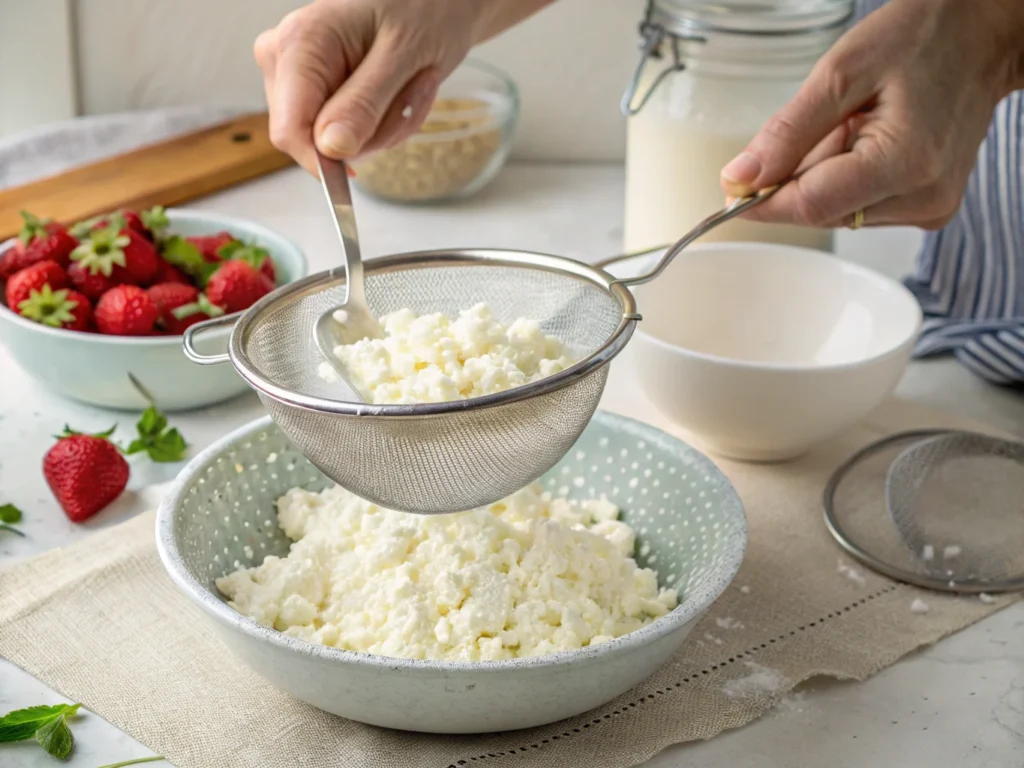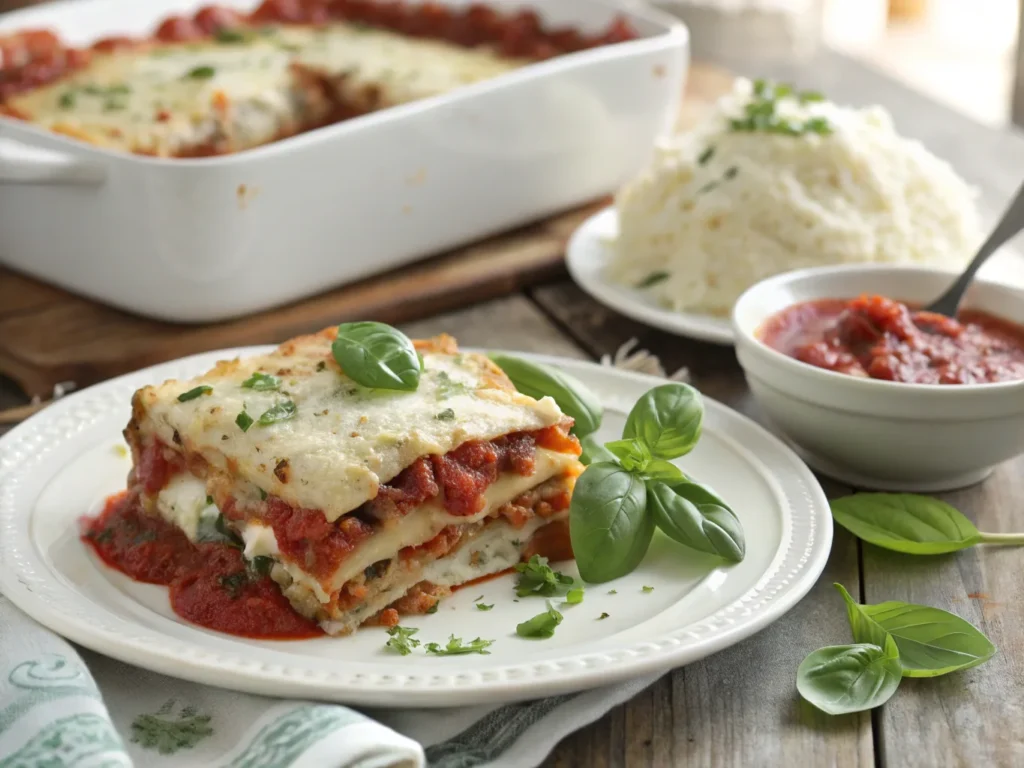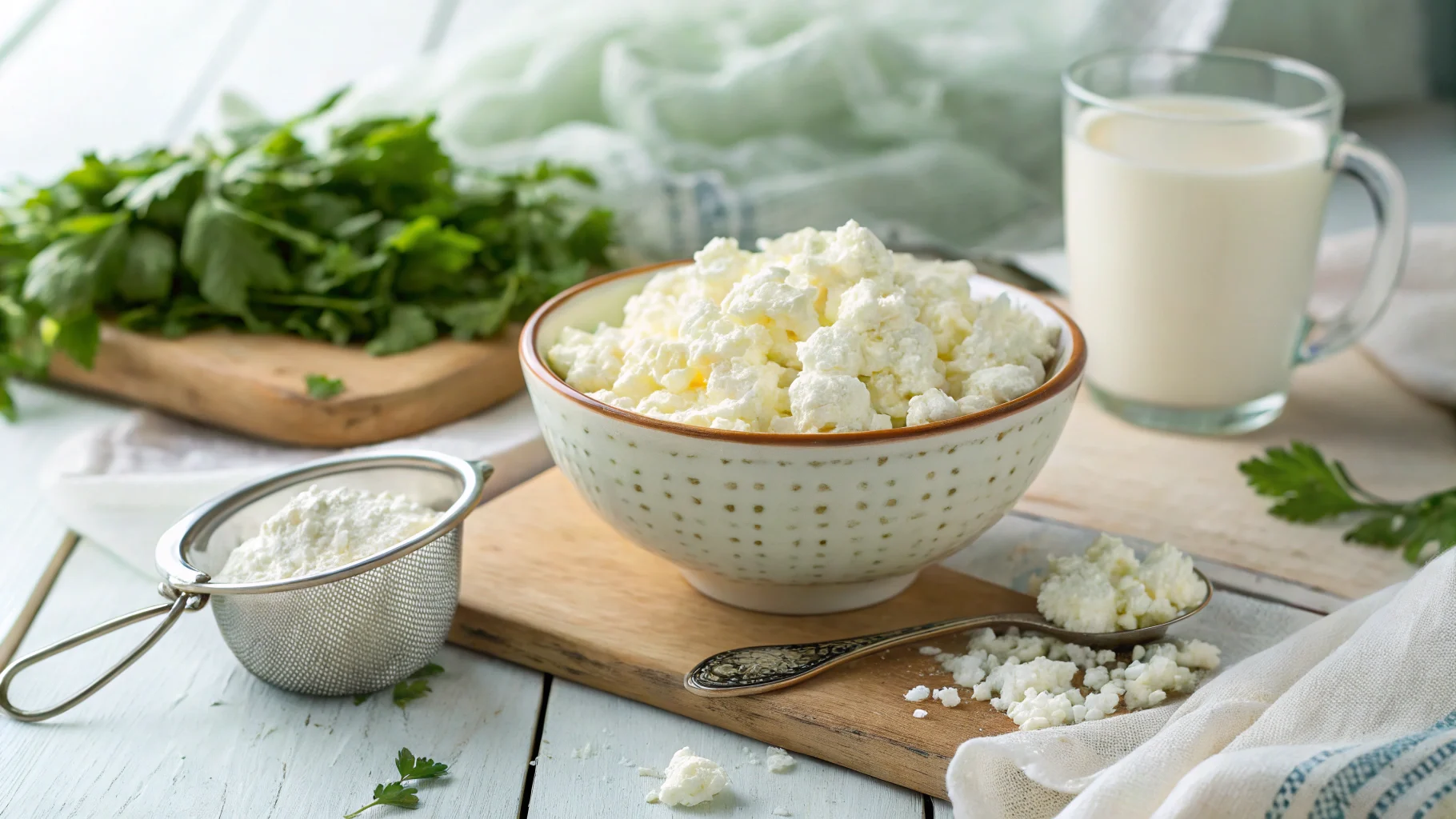Cottage cheese is a staple in many households, praised for its creamy texture, versatility, and impressive nutritional profile. Whether you’re crafting a savory dip, baking a cheesecake, or simply enjoying it as-is, cottage cheese offers endless culinary possibilities. However, one question often arises: should you drain cottage cheese?
In this comprehensive guide, we’ll explore the science, methods, and practical tips for draining cottage cheese. We’ll also uncover when it’s necessary, when it’s not, and how it can elevate your favorite recipes. Let’s unravel the mystery of this beloved dairy product.
Table of contents
Understanding Cottage Cheese
What is Cottage Cheese?
Cottage cheese is a fresh, soft cheese made from the curds of pasteurized cow’s milk. Unlike aged cheeses, cottage cheese has a mild, slightly tangy flavor and a unique texture, thanks to its small curds. The curds are typically suspended in a milky liquid called whey, which gives the cheese its signature creaminess.
Historically, cottage cheese has been a part of diets worldwide. Its name comes from the practice of farmers making the cheese in small “cottages” using leftover milk. Today, it’s a dietary favorite, loved for its low calorie and high protein content.
Types of Cottage Cheese
Not all cottage cheese is created equal. The type you choose can influence whether you need to drain it:
- Creamed Cottage Cheese:
This version contains added cream for richness, making it moist and creamy. It’s commonly sold in tubs and ideal for eating plain or in recipes where extra moisture isn’t a problem. - Dry Curd Cottage Cheese:
Dry curd cottage cheese is made by removing most of the whey, resulting in a crumbly texture. It’s an excellent choice for recipes requiring minimal moisture. - Low-Fat and Full-Fat Cottage Cheese:
Low-fat versions are lighter and less creamy, while full-fat options are richer and often more satisfying. Both can contain varying amounts of liquid, depending on the brand.
Understanding these variations will help you decide whether to drain your cottage cheese based on your needs.
Why Drain Cottage Cheese?
The Role of Liquid (Whey) in Cottage Cheese
The liquid in cottage cheese, known as whey, is a byproduct of the cheese-making process. Whey is rich in nutrients like protein, vitamins, and minerals, contributing to cottage cheese’s overall nutritional profile. However, its presence also makes cottage cheese wetter, which can impact its usability in certain recipes.
While the whey enhances creaminess and hydration, it may not always be suitable for specific dishes requiring a thicker or drier consistency.
Common Reasons to Drain Cottage Cheese
Draining cottage cheese is essential in certain scenarios, especially when texture and moisture levels matter:
- Recipes That Need a Thicker Consistency:
Moisture can interfere with the structure of baked goods or layered dishes like lasagna. Draining ensures the cottage cheese holds its shape and doesn’t create a soggy mess. - Better Texture for Spreads and Dips:
Cottage cheese can make dips too runny if not drained. Removing excess liquid allows for a smoother, creamier spread. - Substituting Ricotta Cheese:
Cottage cheese is often used as a substitute for ricotta in recipes like cannoli or stuffed shells. Draining helps replicate ricotta’s dense, creamy texture. - Reducing Watery Results:
Excess liquid can dilute flavors in savory dishes and affect cooking times. Draining improves the final product’s taste and presentation.
When Draining Isn’t Necessary
In some cases, draining cottage cheese isn’t required and might even be counterproductive:
- Smoothies and Sauces:
If you’re blending cottage cheese into smoothies or sauces, the liquid contributes to the creaminess and doesn’t need to be removed. - Eating Plain:
For those who enjoy cottage cheese straight from the container, the liquid is part of the experience, adding to its refreshing texture and flavor. - Moisture-Rich Recipes:
Certain dishes, like soups or casseroles, benefit from the added liquid, which helps maintain moisture and prevent drying out.
The Verdict: To Drain or Not to Drain?
Ultimately, the decision to drain cottage cheese comes down to the recipe and personal preference. Understanding the role of liquid in your dish will help you determine whether draining is necessary.
Explore our complete list of high-protein recipes featuring cottage cheese.

How to Drain Cottage Cheese (Step-by-Step)
Methods to Drain Cottage Cheese
Draining cottage cheese may sound complicated, but it’s quite simple with the right tools and techniques. Whether you need to remove a little moisture or achieve a very dry consistency, the following methods will help:
- Using a Fine Mesh Sieve:
- Place a fine mesh sieve or strainer over a bowl to catch the liquid.
- Pour the cottage cheese into the sieve, allowing the whey to drip through naturally.
- Let it sit for 10–15 minutes. For faster results, gently press the cheese with the back of a spoon.
- Cheesecloth Technique:
- Line a bowl or strainer with a piece of clean cheesecloth.
- Pour the cottage cheese onto the cheesecloth, then gather the edges to form a pouch.
- Twist the cloth to squeeze out the liquid manually. For a hands-free approach, tie the pouch and hang it over the sink or a bowl, allowing it to drain for 30 minutes to an hour.
- Pressing with Weights:
- Place the cottage cheese on a plate lined with paper towels or cheesecloth.
- Cover it with another paper towel, then place a flat object (like another plate) on top. Add a heavy weight, such as a can of food or a small pot.
- Let it sit for 10–20 minutes, periodically checking to remove the liquid.
Pro Tips for Draining Effectively
Maximize your results with these handy tips:
- Refrigerate While Draining:
If you’re draining the cottage cheese for more than 15 minutes, keep it in the fridge to maintain freshness and prevent spoilage. - Time-Saving Hack:
Short on time? Use a clean kitchen towel or sturdy paper towels to press the cheese quickly. Wrap the cheese, press it with your hands, and discard the towels once they absorb the liquid. - Choose the Right Tool:
A fine mesh sieve is ideal for most draining needs, while cheesecloth offers more flexibility if you want very dry cottage cheese. - Be Gentle:
Avoid over-pressing, as it can crush the curds and ruin the texture.
Visual Guide to Draining Cottage Cheese
Imagine this step-by-step process:
- Set up your sieve or cheesecloth over a clean bowl.
- Pour the cottage cheese in gently to avoid spilling.
- Allow gravity to do the work or apply light pressure with a spoon.
- Check periodically, and stop when you reach your desired dryness level.
By following these steps, you’ll have perfectly drained cottage cheese, ready to use in your favorite recipes.
Recipes That Benefit from Drained Cottage Cheese
1. Lasagna
Lasagna is a classic dish where drained cottage cheese can make a world of difference. Excess moisture from undrained cheese can create a watery, uneven texture, ruining the structural integrity of the dish.
Why Drain It?
Draining cottage cheese gives it a consistency closer to ricotta, ensuring that the layers of pasta, sauce, and cheese hold together beautifully.
Quick Recipe:
- Ingredients:
- 2 cups drained cottage cheese
- 1 box lasagna noodles
- 1 jar marinara sauce
- 2 cups shredded mozzarella cheese
- 1 lb ground beef or turkey (optional)
- 1 egg (to bind the cottage cheese)
- Instructions:
- Cook the noodles according to package directions.
- Mix the drained cottage cheese with one beaten egg.
- Layer the noodles, sauce, meat (if using), and the cottage cheese mixture in a baking dish.
- Top with mozzarella cheese and bake at 375°F (190°C) for 40–45 minutes.

2. Cheesecake
Cheesecake is another dish where the texture is key. Cottage cheese provides a lighter, protein-packed alternative to cream cheese, but the whey can interfere with the silky smoothness expected in this dessert.
Why Drain It?
Draining removes excess liquid, ensuring the cheesecake sets properly and has a rich, creamy consistency.
Quick Recipe:
- Ingredients:
- 2 cups drained cottage cheese
- 1 cup sugar
- 2 eggs
- 1 tsp vanilla extract
- 1 prepared graham cracker crust
- Instructions:
- Blend the drained cottage cheese in a food processor until smooth.
- Add sugar, eggs, and vanilla; blend until combined.
- Pour the mixture into the crust and bake at 325°F (160°C) for 45–50 minutes.
3. Savory Dips and Spreads
Drained cottage cheese is perfect for making thick, flavorful dips and spreads. When undrained, the whey can dilute seasonings and create a runny texture.
Why Drain It?
Draining helps the dip hold its shape, making it ideal for serving with crackers, vegetables, or as a spread.
Quick Recipe for Garlic-Herb Cottage Cheese Dip:
- Ingredients:
- 2 cups drained cottage cheese
- 1 clove garlic, minced
- 2 tbsp fresh parsley, chopped
- 1 tbsp dill
- 1 tsp lemon juice
- Salt and pepper to taste
- Instructions:
- Mix all ingredients in a blender or food processor until smooth.
- Chill for 30 minutes and serve.
Key Takeaway
Draining cottage cheese is the secret to taking these recipes from good to great. By removing excess liquid, you’re enhancing texture, flavor, and overall presentation. Whether it’s a hearty lasagna, a creamy cheesecake, or a delicious dip, properly prepared cottage cheese ensures culinary success.
Nutritional Perspective
Impact of Draining on Nutrition
Draining cottage cheese doesn’t just affect texture—it can also slightly alter its nutritional profile. The whey that’s removed during draining contains nutrients like protein, calcium, and potassium. However, the impact on overall nutrition is minimal, as the curds retain most of the valuable nutrients.
- Protein Content: Cottage cheese is a protein powerhouse. While a small amount of protein is lost in the whey, the curds remain rich in casein protein, which is slow-digesting and excellent for muscle repair and growth.
- Caloric Changes: Draining may slightly reduce calorie content, especially in creamed versions, as some fat from the liquid is removed. However, the difference is negligible for most people.
- Minerals: Some calcium and potassium are lost with the whey. If these nutrients are a concern, consider consuming the whey or opting for fortified foods in your diet.

Health Benefits of Cottage Cheese
Cottage cheese is celebrated for its health benefits, making it a favorite among fitness enthusiasts and health-conscious individuals. Here’s why it’s worth including in your diet:
- High Protein, Low Calories:
Cottage cheese provides a substantial amount of protein without a high calorie count, making it an excellent choice for weight loss or maintenance. - Rich in Calcium:
Calcium supports strong bones and teeth, and cottage cheese is an accessible way to boost your intake. - Supports Muscle Building:
Athletes and bodybuilders appreciate cottage cheese for its casein protein, which promotes muscle recovery and sustains energy levels. - Versatile for Various Diets:
Cottage cheese suits low-carb, ketogenic, and high-protein diets, offering flexibility for those with specific dietary goals.
Does Draining Remove Too Much Nutrition?
While draining removes some nutrients, the overall impact is minor. If you’re concerned about nutrient loss, consider using the whey in smoothies, soups, or baked goods to retain its benefits.
Learn more about the best ways to store cottage cheese to keep it fresh.
FAQs
Does rinsing cottage cheese remove sodium?
Rinsing cottage cheese can remove some of the sodium, but not all. It may reduce the sodium content slightly, depending on how much liquid is drained off.
What does Collins mean by rinsing the cottage cheese?
Collins refers to the process of draining and rinsing cottage cheese to remove excess liquid and reduce its salt content, making it taste fresher and less salty.
Why do you use cottage cheese in baking?
Cottage cheese is used in baking for its moisture content, texture, and ability to provide a creamy consistency. It’s often used in recipes like casseroles, cakes, or savory dishes to add richness without being too heavy.
Are you supposed to drain cottage cheese?
Yes, you should drain cottage cheese if you want to reduce its excess liquid, especially when it’s used in recipes where too much moisture can affect the texture or flavor.
Conclusion and Final Thoughts
Cottage cheese is a versatile ingredient that shines in both savory and sweet recipes. Whether you enjoy its creamy texture straight from the container or use it as a key component in culinary creations, understanding when and how to drain it can elevate your cooking.
Draining cottage cheese is especially beneficial for recipes requiring a thicker consistency, such as lasagna, cheesecake, or dips. It removes excess whey, enhancing texture and ensuring the best possible results. On the other hand, certain dishes, like smoothies or casseroles, don’t require draining, as the liquid contributes to a smoother or more cohesive outcome.
From improving recipe outcomes to adjusting for personal preferences, draining cottage cheese is a simple yet impactful kitchen hack. By mastering this technique, you can unlock the full potential of this beloved dairy product and take your dishes to the next level.
So, the next time you reach for cottage cheese, consider your recipe, your goals, and your taste preferences. Whether drained or left as-is, cottage cheese remains a nutritious and delicious staple that deserves a place in your kitchen.
Happy cooking!

